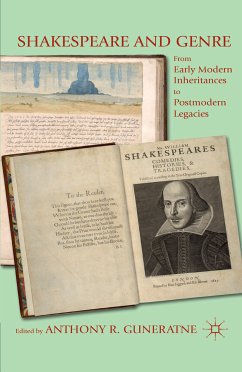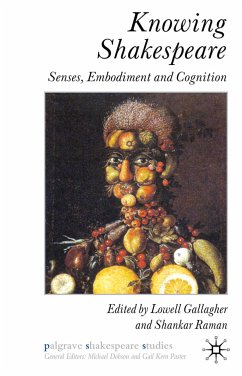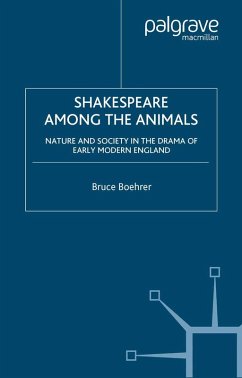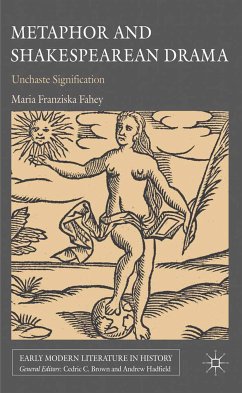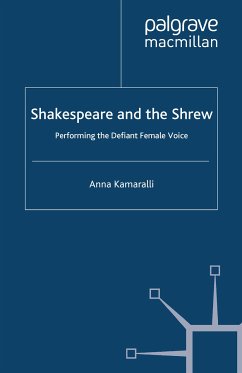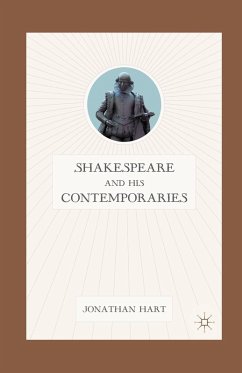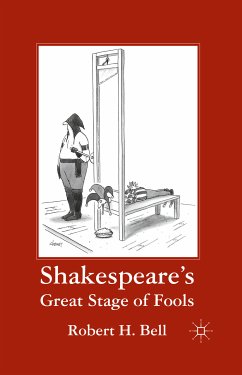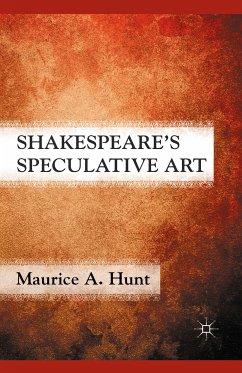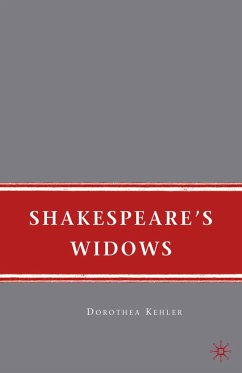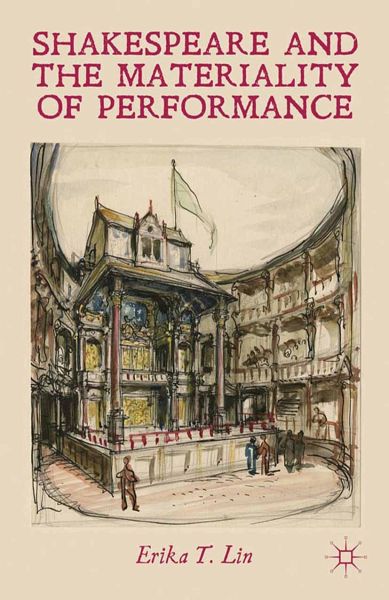
E. Lin
eBook, PDF
Shakespeare and the Materiality of Performance (eBook, PDF)

PAYBACK Punkte
20 °P sammeln!






Winner of the MRDS 2013 David Bevington Award for Best New Book in Early Drama Studies! Drawing on a wide variety of primary sources, Lin reconstructs playgoers' typical ways of thinking and feeling and demonstrates how these culturally-trained habits of mind shaped dramatic narratives and the presentational dynamics of onstage action.
Dieser Download kann aus rechtlichen Gründen nur mit Rechnungsadresse in A, B, BG, CY, CZ, D, DK, EW, E, FIN, F, GR, HR, H, IRL, I, LT, L, LR, M, NL, PL, P, R, S, SLO, SK ausgeliefert werden.
Erika T. Lin is Associate Professor in the Ph.D. Program in Theatre at the Graduate Center, The City University of New York, USA
Produktdetails
- Verlag: Palgrave Macmillan US
- Seitenzahl: 238
- Erscheinungstermin: 14. September 2012
- Englisch
- ISBN-13: 9781137006509
- Artikelnr.: 46753637
"Shakespeare and the Materiality of Performance powerfully redirects our attention as scholars of early modern drama to the fact that the plays we discuss were performed before audiences carrying specific cultural assumptions about what it meant to engage in watching and listening to theatrical spectacle. This book is of value to scholars interested in performance theory more broadly but will also be useful to historicist scholars seeking to understand the nuances of bodies, actors, and representational drama converging in particular moments upon the early modern stage . . . Lin's analyses are sharp, provocative, and helpful for scholars seeking to approximate early modern ideological and social conditions of interpretative strategies in
Mehr anzeigen
theater." - Journal of the Northern Renaissance
"Lin's close-readings of the play are often penetrating . . . [Lin] does not overstate the claims she makes; she is cautious with numbers in particular. She is precise with her examples." - Shakespeare Jarhbuch
"Lin's reading of early modern performance traditions and spectatorship serves as a valuable working model for scholars of drama seeking to marry rigorous historical investigations with critical theory. For those interested in reception theory, material studies, and early modern stage practices, Shakespeare and the Materiality of Performance can be read productively alongside other studies in historical phenomenology as well as early modern audience and reception studies." - Theatre Survey
". . . Lin establishes that our theatrical experiences are radically different and how we enter into, perceive, and understand the dramatic stage has little in common with our ancestors . . . In assessing this 'theatrical language', Lin turns to the notion of materiality itself, something which she rightly points out has become a significant focus of Shakespearean studies . . . She emphasizes the role of the theatre and 'entertainment' in the construction of early modern lives, a role - and a visual vocabulary - that we need to learn in order to fully appreciate the differences, rather than the similarities of our play-words" Shakespeare Survey
"In comparing [Cymbline's] representations of mutilation and dismemberment onstage with other accounts, such as the execution of criminals, accounts of martyrdom, and violent murders, Lin establishes the importance of the body, and how it (and its parts) may have been viewed by the audience." Year's Work in English Studies
"...This is an important book for scholars of early modern drama in performance. It could also enrich the work of practitioners, and its examination of the psychology of audiences could benefit cognitive studies as well. Lin's work is engaging and at times even exciting: there is a sense that she is revealing hidden mysteries of the past, that the reader is entering the early modem playhouse as it once was. I wish that more scholars would engage in such meticulously informed speculation about practices that we can never fully recover through other means. Lin also provides convincing explanations for a number of puzzling spots in the plays. She is especially good at pointing out the blinders that modem scholars and practitioners wear because of their own cultural and theatrical assumptions." Medieval and Renaissance Drama in England
"Although Lin examines an impressive range of documents to construct historically situated interpretive paradigms, most astute are her analyses of episodes that critics have either ignored or explained through 'elaborate conjectures', such as the witches' dance in Macbeth and the irreverent stage play of bodily mutilation in Titus Andronicus (p. 157). Lin's work intervenes in the study of early modern drama and culture and shifts the conversation toward a focus on those who populated the offstage world of the play. These interpreters might well have considered Hamlet as the show with the exciting 'swordfight in the final act' and understood Doctor Faustus as a play that 'sports with severed limbs' (p. 164), and so, perhaps, should we." Theatre Research International
"Lin's close-readings of the play are often penetrating . . . [Lin] does not overstate the claims she makes; she is cautious with numbers in particular. She is precise with her examples." - Shakespeare Jarhbuch
"Lin's reading of early modern performance traditions and spectatorship serves as a valuable working model for scholars of drama seeking to marry rigorous historical investigations with critical theory. For those interested in reception theory, material studies, and early modern stage practices, Shakespeare and the Materiality of Performance can be read productively alongside other studies in historical phenomenology as well as early modern audience and reception studies." - Theatre Survey
". . . Lin establishes that our theatrical experiences are radically different and how we enter into, perceive, and understand the dramatic stage has little in common with our ancestors . . . In assessing this 'theatrical language', Lin turns to the notion of materiality itself, something which she rightly points out has become a significant focus of Shakespearean studies . . . She emphasizes the role of the theatre and 'entertainment' in the construction of early modern lives, a role - and a visual vocabulary - that we need to learn in order to fully appreciate the differences, rather than the similarities of our play-words" Shakespeare Survey
"In comparing [Cymbline's] representations of mutilation and dismemberment onstage with other accounts, such as the execution of criminals, accounts of martyrdom, and violent murders, Lin establishes the importance of the body, and how it (and its parts) may have been viewed by the audience." Year's Work in English Studies
"...This is an important book for scholars of early modern drama in performance. It could also enrich the work of practitioners, and its examination of the psychology of audiences could benefit cognitive studies as well. Lin's work is engaging and at times even exciting: there is a sense that she is revealing hidden mysteries of the past, that the reader is entering the early modem playhouse as it once was. I wish that more scholars would engage in such meticulously informed speculation about practices that we can never fully recover through other means. Lin also provides convincing explanations for a number of puzzling spots in the plays. She is especially good at pointing out the blinders that modem scholars and practitioners wear because of their own cultural and theatrical assumptions." Medieval and Renaissance Drama in England
"Although Lin examines an impressive range of documents to construct historically situated interpretive paradigms, most astute are her analyses of episodes that critics have either ignored or explained through 'elaborate conjectures', such as the witches' dance in Macbeth and the irreverent stage play of bodily mutilation in Titus Andronicus (p. 157). Lin's work intervenes in the study of early modern drama and culture and shifts the conversation toward a focus on those who populated the offstage world of the play. These interpreters might well have considered Hamlet as the show with the exciting 'swordfight in the final act' and understood Doctor Faustus as a play that 'sports with severed limbs' (p. 164), and so, perhaps, should we." Theatre Research International
Schließen
Für dieses Produkt wurde noch keine Bewertung abgegeben. Wir würden uns sehr freuen, wenn du die erste Bewertung schreibst!
Eine Bewertung schreiben
Eine Bewertung schreiben
Andere Kunden interessierten sich für


